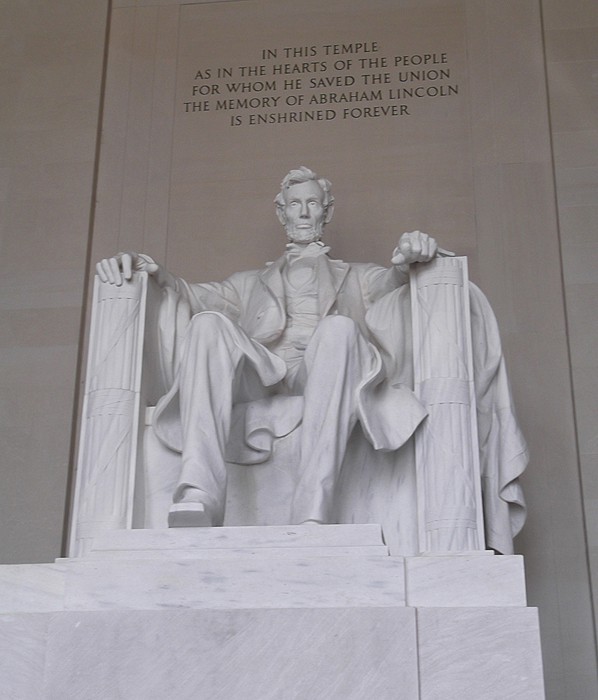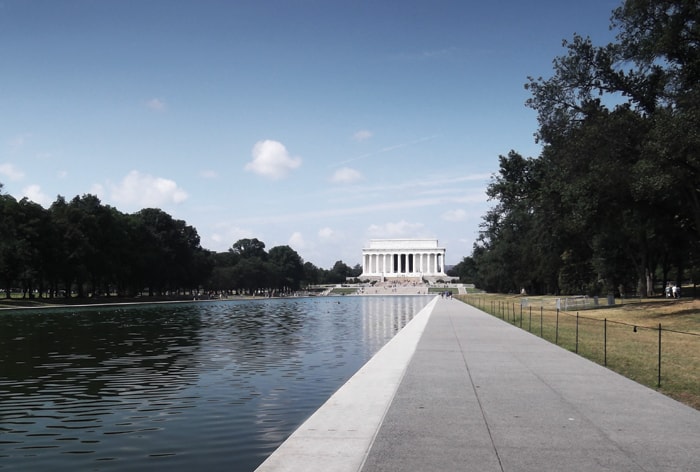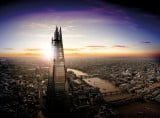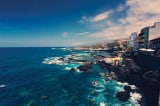The capital city of the United States and a Mecca for history and culture enthusiasts, there’s much more to Washington DC than just a set for The West Wing, writes Anne Whelton.
It’s a hot day in the city. Still over 30 degrees in fact – and what we would consider unseasonably hot for early September – when we touch down in Reagan National Airport in the early evening.
My travel companion is worried about our hotel’s air-conditioning; as am I once the wall of heat hits me; and equally worried about our busy itinerary of sightseeing in 30+ degree heat. A short metro ride and a long nap later and our worries have significantly subsided. Unfortunately, the same can’t be said of the heat once we leave our cool hotel room to explore night-time DC.
Luckily, our hotel is in the heart of the financial district and just a short walk from some of the world’s most famous monuments. Within five minutes we’re in sight of the National Mall and Washington Monument. Bearings got, we decide to retreat back once again to the cool haven of our hotel and leave the exploring for the next morning.
The North, South, East and West Wing
First stop on any whistle-stop tour of DC is the city’s, and indeed the country’s, most famous address, 1600 Pennsylvania Avenue. As important historical residences go, the White House is in fact, quite inconspicuous. Nestled between Pennsylvania Avenue and E Street, designed by Irish-born architect James Hoban and built between 1792 and 1800, it can be easily missed in DC’s skyline. However, as one of the oldest public buildings in Washington DC and the residence of America’s most important citizen, it is certainly worth a visit. You never know, you might just spot Mr Obama and Bo taking a stroll around the North Lawn if you’re lucky.
Located directly across Pennsylvania Avenue you will find Lafayette Park, a seven-acre public park that over the years has served as a race track, a graveyard, a zoo, a slave market, an encampment for soldiers during the War of 1812, and many political protests and celebrations. Nowadays, it’s the perfect location to take a break from sightseeing and meet some locals. With the White House as its backdrop, one can also imagine many a political battle – both real and fictional –has been lost and won on the benches of Lafayette Park.
Museum mile

Uncle Sam needs you.
Setting our political hats to one side, it’s time to soak up some history, and air conditioning, in one of Washington DC’s many museums. First stop is the Smithsonian Institution, the world’s largest museum complex and research organisation, on the National Mall. For anyone with even a passing interest in history or culture, the Smithsonian is an absolute ‘must see’ for visitors to DC and best of all, it’s completely free. Comprised of 19 museums and galleries and the National Zoological Park, the total number of objects, works of art and specimens at the Smithsonian is estimated to be over 130 million. With everything from Sputnik, the Hope Diamond and the Star-Spangled Banner to Abraham’s Lincoln’s famous top hat and Dorothy’s ruby slippers, the Smithsonian collection is both breath-taking and awe-inspiring and almost impossible to experience in its totality.
While serious culture buffs could spend weeks wandering around the Smithsonian, with limited time it’s a good idea to choose three or four key museums and spend a few hours in each rather than 10 minutes in every museum on the Mall.
Our first stop for the day is the National Air and Space Museum, which is home to the world’s largest collection of aviation and space artifacts and welcomes, on average, eight million people annually. A museum for kids and big kids alike, the Air and Space Museum houses everything from the iconic 1903 Wright Flyer, the Spirit of St Louis and Luftwaffe airplanes from WWII, to the Apollo 11 command module Columbia from the first moon landing mission, the Hubble Space Test Telescope and even a piece of moon rock.
After the Air and Space Museum we decide to come back down to earth and head to the Natural History Museum across the Mall. Here, we get to ogle the Hope Diamond in all its glory, step into history and walk with dinosaurs in the museum’s Hall of Paleobiology, and trace our family tree all the way back to human origins. Again, a ‘must-see’ attraction, particularly if you are travelling with children.
Our last museum of the day to visit, after a quick stop off to admire some artwork in the National Portrait Gallery, is the American History Museum. Not so much a museum, as a complete collection of everything you could possible think of, or associate with the American psyche, the American History Museum houses the Star-Spangled Banner that inspired the anthem, a life vest from the ill-fated RMS Titanic, Julia Child’s kitchen, the ruby slippers from The Wizard of Oz, Muhammad Ali’s boxing gloves, Abraham Lincoln’s top hat, Bill Clinton’s saxophone, George Washington’s military uniform and everything in between – you name it and this museum has it. Visitors can easily lose track of time and spend hours wandering around the museum’s many collections, so make sure to clear your schedule before making the trip.
Apart from all that the Smithsonian has to offer, other notable museums that are worth including on your cultural checklist of DC include Newseum, an interactive museum of news and journalism, and the International Spy Museum, which serves as an excellent insight into the world of espionage and will please James Bond fans to no end.
After a long day of immersing ourselves in all the culture DC had to offer, it was time to experience what the city had to offer after the sun goes down. A short taxi journey, brought us to the preppy, university-centred area of Georgetown, famous for its restaurants, chic wine bars and clubs. If you’re looking for more history and a bite to eat while in Georgetown, you won’t do much better than Billy Martin’s Tavern, which has served every US president since Harry Truman and is the alleged location of JKF’s proposal to a certain Jacqueline Bouvier.
Honouring the past
The next day we decide to risk sunstroke and brave DC’s outdoor sights and attractions. Luckily, most of DC’s famous monuments and memorials are within walking distance of one another. Walking from the Lincoln Memorial to the Jefferson Memorial, you’ll cross the grounds of the Korean War Memorial, the Vietnam Memorial, the Reflecting Pool, the World War II Memorial and the Washington Monument, all of which are worth visiting.
First stop for us was the Lincoln Memorial. As thought-provoking as it is grand, standing under Lincoln’s likeness is akin to admiring the impressive façade of a Greek or Roman Temple – though hundreds of years younger. Its designer, American sculptor Clark Mills, certainly knew how to make an impact.
Of course the Lincoln Memorial also has a history lesson from the 20th century to teach us, most notably from the 1960s, during the Civil Rights and the anti-Vietnam War movements, and it was on the steps of the Lincoln Memorial, looking out across the Reflecting Pool that Martin Luther King Jr delivered his famous ‘I Have a Dream’ speech.

The majesty of the Lincoln Memorial.
Just south of the Lincoln Memorial and across the Potomac River is Arlington National Cemetery. Covering some 624 acres, divided into 70 sections and comprising of the graves of over 400,000 US war heroes, a visit to this famous cemetery is not for the faint-hearted. While you can take a bus tour of the cemetery, the beauty and serenity of this hallowed place is best experienced on foot, but make sure to bring a good pair of walking shoes. Notable Americans buried in Arlington include JFK, whose grave is marked with an ‘eternal flame’, Jacqueline Kennedy Onassis and Robert Kennedy. There are also memorials for the Space Shuttles Challenger and Columbia and the Tomb of the Unknown Soldier.
While DC undoubtedly has its place in the political landscape of modern day America, it is for the city’s culture and history that I will remember my trip to this distinguished capital city.
Out and about
Getting there:
Aer Lingus operates flights from Dublin to Washington DC, Dulles Airport daily and Dublin and Shannon to Reagan Airport via a connection in Boston. For more details and to make a booking, log on to www.aerlingus.com
Getting around:
Despite its size, DC is relatively easy to navigate on foot. If you’re just in town to visit the museums, you’ll find all you need on, or within, a stone’s throw of the National Mall. If you want to venture further afield, the Washington Metrorail and Metrobus are good alternatives to sitting in the city’s renowned traffic conjection – DC was voted most congested metropolitan area in the US for 2013.
Staying there:
As with most cities in the US, there are plenty of chain hotels in and around Downtown DC and Dupont Circle.
We set up camp in the four-star Club Quarters (www.clubquarters.com), located in the city’s business district and just two blocks from the White House which proved the perfect location for a short walk to the sights on the National Mall. Rooms start from about $130 p.n.
Many of DC’s hotels are famed for hosted some of the country’s most important political leaders. One such hotel, the Mayflower Renaissance (www.marriott.com), has plenty to offer the business traveller or tourist. A Marriott hotel located on Connecticut Avenue, the Mayflower has hosted former presidents J Edgar Hoover and John F Kennedy. Rooms start from about $170 p.n.
Similarly, The Loews Madison (www.loewshotels.com) on 15th Street is also famous for hosting every US president since Kennedy, so you never know who you might bump into in the hotels revered halls. Rooms at The Madison start from about $180 p.n.
Eating out:
Some might forget that DC is on the coast, so if you need reminding just pay a visit to one of the city’s many seafood restaurants and sample a DC and Maryland favourite in the form of East Coast crab cakes.
Other dining highlights in DC include Komi, (komirestaurant.com) which has no menu, rather diners are served a multi-course tasting dinner of culinary delights. A certain Mr and Mrs Obama are fans.
Speaking of famous patrons, Ben’s Chilli Bowl (benschilibowl.com) on U Street has fed and watered everyone from Ella Fitzgerald, Martin Luther King Jr, Bill Cosby, Bono, George W. Bush and President Barack Obama and is as much a part of DC’s cultural soul as the city’s many monuments.
For more information on Washington DC log on to http://washington.org







